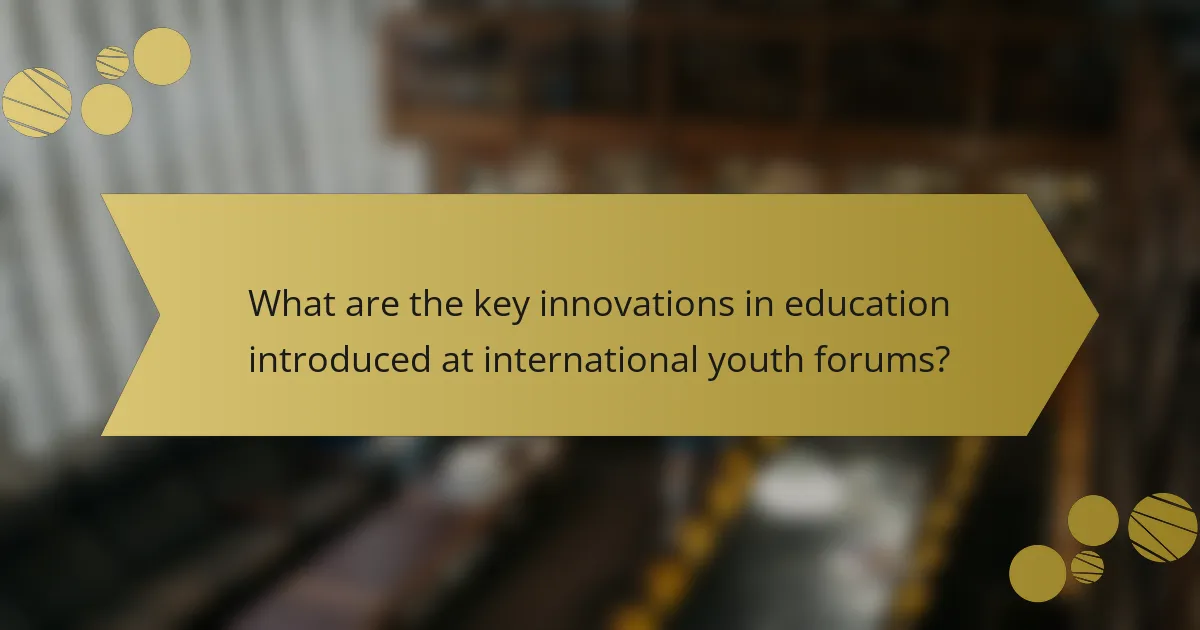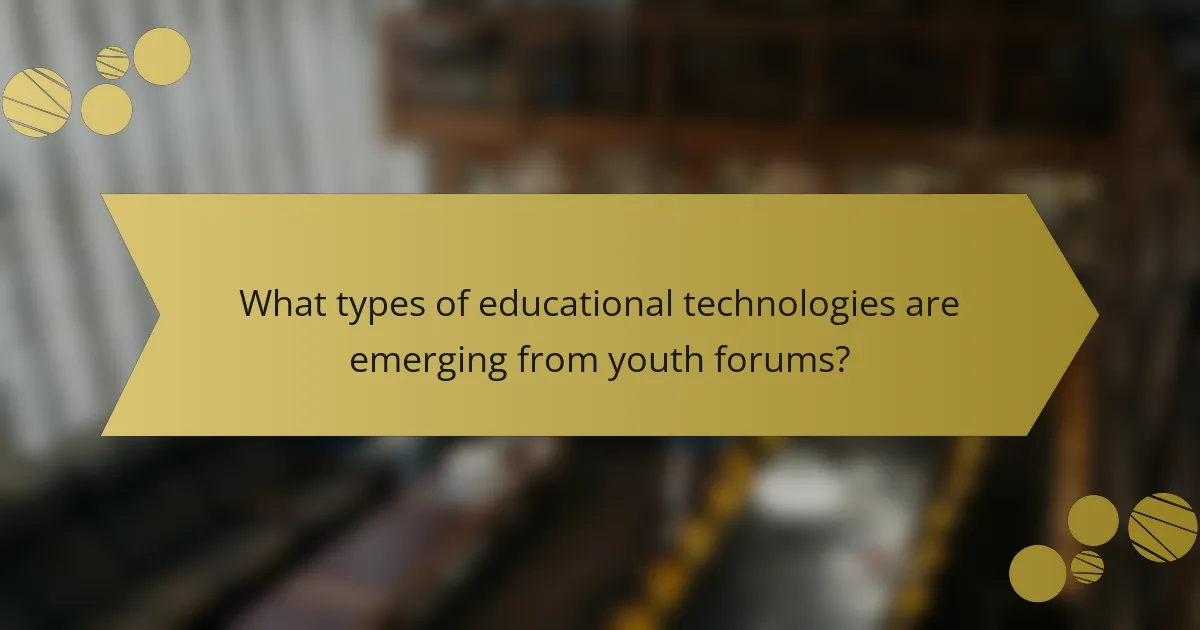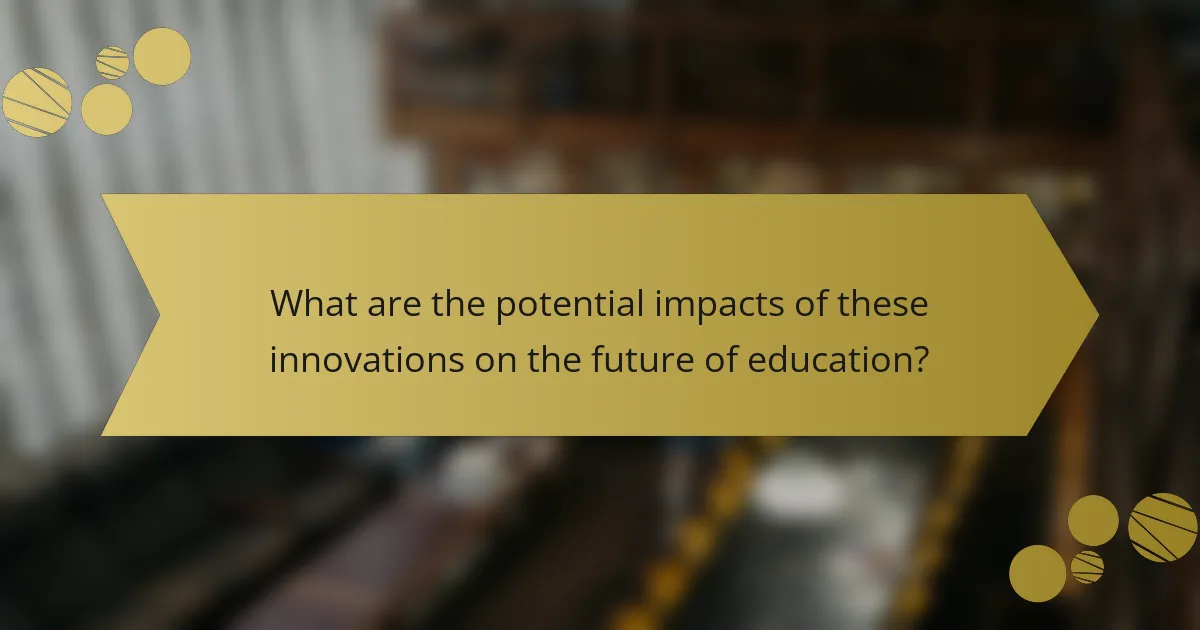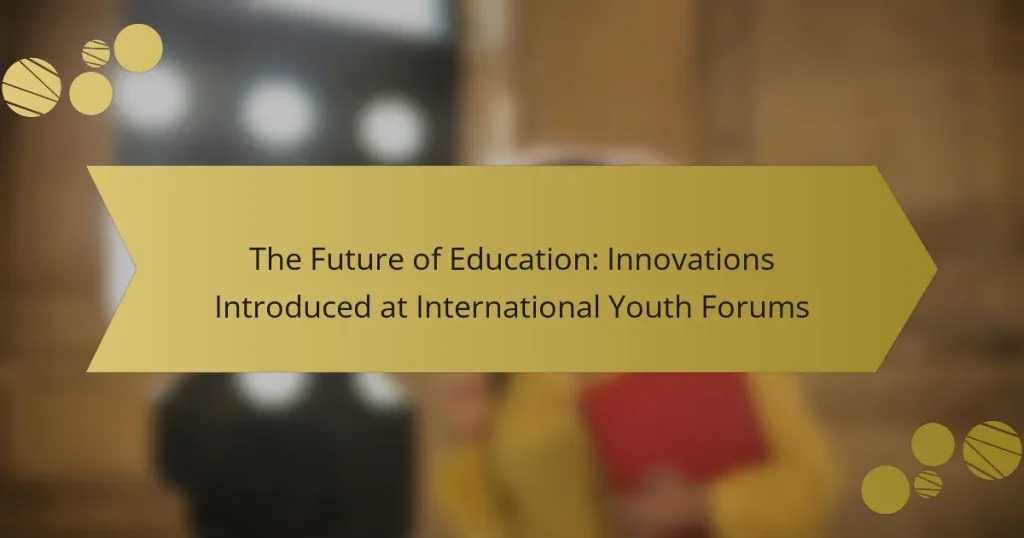The article focuses on key innovations in education introduced at international youth forums, emphasizing digital learning platforms, collaborative projects, and experiential learning methods. These innovations enhance accessibility, promote teamwork, and provide hands-on experiences, ultimately engaging youth and preparing them for future challenges. Additionally, emerging educational technologies such as collaborative online platforms, interactive learning applications, and gamified tools are highlighted for their role in improving educational engagement and outcomes. The article discusses how these advancements aim to create a more inclusive and effective educational landscape by leveraging technology to cater to diverse student needs and foster global collaboration.

What are the key innovations in education introduced at international youth forums?
Key innovations in education introduced at international youth forums include digital learning platforms, collaborative projects, and experiential learning methods. Digital learning platforms enhance accessibility and allow for personalized education. Collaborative projects encourage teamwork and problem-solving among diverse groups. Experiential learning methods provide hands-on experiences that deepen understanding. These innovations aim to engage youth more effectively and prepare them for future challenges. Evidence from various forums shows increased student engagement and improved learning outcomes associated with these approaches.
How do these innovations address current educational challenges?
Innovations introduced at international youth forums address current educational challenges by enhancing accessibility and engagement. These innovations often incorporate technology, such as online learning platforms and interactive tools. For example, virtual classrooms allow students from remote areas to access quality education. Gamification techniques make learning more engaging, improving student motivation and retention. Additionally, these innovations promote collaboration through peer-to-peer learning and global networking opportunities. Research shows that technology integration can lead to improved academic performance. A study by the U.S. Department of Education found that students in tech-rich environments performed better than their peers. Thus, these innovations effectively tackle barriers in education by making learning more inclusive and dynamic.
What specific issues in education are being targeted by these innovations?
Innovations introduced at international youth forums target several specific issues in education. These include enhancing accessibility to quality education for marginalized groups. They also focus on improving engagement through interactive learning methods. Another issue is the integration of technology to facilitate remote learning. Innovations aim to address skill gaps by aligning curricula with industry needs. They seek to promote inclusivity by accommodating diverse learning styles. Additionally, these innovations tackle the lack of resources in underfunded schools. They also emphasize the importance of mental health support within educational settings. Overall, these innovations aim to create a more equitable and effective educational landscape.
How do these innovations enhance student engagement and learning outcomes?
Innovations introduced at international youth forums enhance student engagement and learning outcomes by incorporating interactive technology and collaborative learning methods. Interactive technology, such as virtual reality and gamification, captivates students’ attention and makes learning more enjoyable. This engagement leads to increased motivation and participation in educational activities. Collaborative learning methods foster teamwork and communication skills among students. Research shows that students who collaborate effectively tend to achieve higher academic performance. Additionally, these innovations often provide personalized learning experiences. Tailoring content to individual learning styles can significantly improve comprehension and retention. Overall, these advancements create a more dynamic and effective educational environment.
Why are international youth forums important for educational innovation?
International youth forums are crucial for educational innovation because they foster collaboration among diverse young minds. These forums provide a platform for sharing ideas and best practices. Participants can discuss global educational challenges and propose innovative solutions. Research shows that youth engagement in such forums leads to increased creativity and problem-solving skills. According to a study by UNESCO, youth participation enhances educational outcomes by integrating fresh perspectives. Furthermore, international youth forums encourage cross-cultural understanding, which is essential for global citizenship education. This exchange of knowledge and experiences drives the development of new educational models. Thus, international youth forums play a significant role in shaping the future of education.
What role do youth forums play in shaping educational policies?
Youth forums play a significant role in shaping educational policies by providing a platform for young voices. These forums allow youth to express their perspectives on educational issues. They facilitate discussions about the challenges and needs of students. Policymakers often consider the input from these forums in their decision-making processes. For instance, UNESCO reports that youth engagement leads to more inclusive policies. Evidence shows that countries with active youth participation in education policy see improved outcomes. Youth forums can influence curriculum changes and funding priorities. They also promote awareness of global educational trends and innovations.
How do diverse perspectives from youth contribute to educational advancements?
Diverse perspectives from youth contribute to educational advancements by introducing innovative ideas and solutions. Young individuals bring fresh viewpoints shaped by their unique backgrounds and experiences. These perspectives often challenge traditional educational methods. They encourage the incorporation of technology and modern teaching practices. Research shows that student-led initiatives enhance learning outcomes. A study by the OECD highlights that youth engagement fosters critical thinking and creativity. Diverse voices ensure that education is relevant and inclusive. This inclusivity leads to a more equitable educational environment. Ultimately, youth perspectives drive continuous improvement in educational systems.

What types of educational technologies are emerging from youth forums?
Emerging educational technologies from youth forums include collaborative online platforms, interactive learning applications, and gamified educational tools. Collaborative online platforms facilitate peer-to-peer learning and resource sharing. For example, platforms like Google Classroom allow students to engage and collaborate on projects remotely. Interactive learning applications enhance engagement through multimedia content and real-time feedback. Tools such as Kahoot! and Quizlet enable students to learn through quizzes and interactive games. Gamified educational tools incorporate game elements into learning experiences, increasing motivation and retention. Programs like Duolingo exemplify this approach by making language learning fun and engaging. These technologies reflect the innovative ideas shared by youth, aiming to improve educational accessibility and engagement.
How are digital platforms being utilized for educational purposes?
Digital platforms are utilized for educational purposes by facilitating online learning, collaboration, and resource sharing. These platforms enable students to access a wide range of educational materials. They support interactive learning through videos, quizzes, and discussion forums. For instance, platforms like Coursera and Khan Academy offer courses from top universities. Additionally, tools like Google Classroom streamline communication between teachers and students. Research indicates that online learning can improve student engagement and retention rates. According to a study by the U.S. Department of Education, blended learning can lead to better academic outcomes. Thus, digital platforms play a crucial role in modern education.
What are the advantages of using digital platforms in education?
Digital platforms in education offer several advantages. They enhance accessibility, allowing students to learn from anywhere with an internet connection. This flexibility caters to diverse learning styles and schedules. Digital platforms also provide a wealth of resources, including interactive content and multimedia materials. These resources can engage students more effectively than traditional textbooks. Furthermore, digital platforms facilitate collaboration among students and teachers through forums and real-time communication tools. This interaction fosters a sense of community and support. Data analytics on these platforms can track student progress, enabling personalized learning experiences. According to a study by the New Media Consortium, 70% of educators believe digital tools improve student engagement.
How do these platforms facilitate collaboration among students globally?
These platforms facilitate collaboration among students globally by providing tools for communication and project management. They enable real-time discussions through chat features and video conferencing. Students can share documents and resources easily, fostering teamwork. Many platforms include forums for idea exchange and feedback. They often support multilingual capabilities, breaking language barriers. Additionally, they allow for the creation of diverse project groups across different countries. This global interaction enhances cultural understanding and collaboration skills. Research shows that such platforms increase student engagement and learning outcomes.
What innovative teaching methods are being introduced?
Innovative teaching methods being introduced include project-based learning and flipped classrooms. Project-based learning engages students through real-world challenges. It promotes critical thinking and collaboration among peers. Flipped classrooms reverse traditional teaching methods. Students learn new content at home and practice in class. These methods enhance student engagement and retention. Research shows that active learning increases academic performance. A study by Freeman et al. (2014) found that active learning improves exam scores by 6%.
How do these methods differ from traditional teaching approaches?
Innovative teaching methods differ from traditional approaches by emphasizing collaboration and active learning. Traditional methods often rely on lectures and rote memorization. In contrast, innovative methods encourage student participation and critical thinking. For example, project-based learning allows students to work on real-world problems. This approach fosters deeper understanding and retention of knowledge. Research shows that active learning can improve student performance by up to 50% compared to traditional methods. Additionally, innovative methods often utilize technology to enhance learning experiences. Traditional approaches typically do not integrate digital tools as effectively. Overall, these differences lead to a more engaging and effective educational environment.
What evidence supports the effectiveness of these new teaching methods?
Research indicates that new teaching methods enhance student engagement and learning outcomes. A study by Hattie (2018) found that interactive teaching strategies can increase student achievement by up to 30%. Furthermore, data from the National Education Association shows that project-based learning improves retention rates by 20% compared to traditional methods. Additionally, a meta-analysis in the Journal of Educational Psychology (2020) revealed that collaborative learning environments boost critical thinking skills significantly. These findings collectively support the effectiveness of innovative teaching methods introduced at international youth forums.

What are the potential impacts of these innovations on the future of education?
Innovations introduced at international youth forums can significantly transform the future of education. They enhance accessibility by leveraging technology, making learning resources available to diverse populations. For instance, online platforms can reach students in remote areas, bridging educational gaps. These innovations also promote personalized learning experiences. Adaptive learning technologies can cater to individual student needs and learning styles. Furthermore, they encourage collaboration among students across the globe. Virtual classrooms enable real-time interaction, fostering a global learning community. Data-driven insights from these innovations can improve teaching methods and curriculum design. Research shows that integrating technology in education can lead to higher engagement and retention rates. Overall, these innovations are poised to create a more inclusive, engaging, and effective educational landscape.
How might these innovations change the role of educators?
Innovations in education may redefine the role of educators by shifting them from traditional knowledge transmitters to facilitators of learning. Educators will increasingly guide students in navigating digital resources and collaborative tools. This transition emphasizes critical thinking and problem-solving skills over rote memorization.
For instance, the integration of artificial intelligence in classrooms allows personalized learning experiences. Educators will need to adapt their teaching strategies to leverage these technologies effectively. Research shows that technology can enhance student engagement and learning outcomes when used appropriately.
As a result, educators will focus more on mentoring and coaching rather than solely delivering content. This change encourages a more student-centered approach, fostering autonomy and creativity in learners.
What skills will educators need to adapt to these changes?
Educators will need skills in digital literacy to adapt to changes in education. This includes the ability to effectively use technology in the classroom. Familiarity with online teaching platforms is essential. Educators should also develop skills in data analysis. Understanding student performance metrics can inform instructional strategies. Collaboration skills are crucial for working with peers and stakeholders. Adaptability to new teaching methods will enhance instructional effectiveness. Continuous professional development is necessary to stay updated on educational trends. Finally, strong communication skills will help educators engage with students and parents effectively.
How can educators leverage these innovations to improve their teaching practices?
Educators can leverage innovations introduced at international youth forums to enhance their teaching practices by integrating technology and collaborative learning methods. These innovations often include digital tools that facilitate interactive learning experiences. For example, platforms like virtual classrooms enable real-time engagement among students and educators.
Additionally, educators can adopt project-based learning approaches that encourage critical thinking and problem-solving. This method aligns with the trends observed in recent educational research, which emphasizes experiential learning.
Furthermore, incorporating data analytics can help educators assess student performance and tailor instruction to meet individual needs. Studies show that personalized learning increases student engagement and achievement.
By staying updated on these innovations, educators can foster a more dynamic and effective learning environment.
What best practices can be adopted from successful educational innovations?
Successful educational innovations often adopt best practices such as personalized learning, collaborative projects, and technology integration. Personalized learning tailors education to individual student needs, enhancing engagement and retention. For instance, the Summit Learning program allows students to progress at their own pace, leading to improved academic outcomes. Collaborative projects foster teamwork and critical thinking skills. Programs like the Global Classroom Project connect students across the globe to work on shared challenges, enhancing cultural awareness and problem-solving abilities. Technology integration, such as using digital tools for interactive learning, has been shown to increase student motivation. Research indicates that schools implementing blended learning models see higher student achievement. These practices contribute to more effective and engaging educational experiences.
How can schools implement these innovations effectively?
Schools can implement innovations effectively by fostering a culture of collaboration among educators. Professional development programs should be established to equip teachers with necessary skills. Schools must integrate technology into the curriculum to enhance learning experiences. Engaging students in the decision-making process promotes ownership of their education. Partnerships with community organizations can provide additional resources and expertise. Regular assessment of the implemented innovations is essential for continuous improvement. Evidence shows that schools with strong leadership see higher success rates in innovation adoption. These strategies create an environment conducive to effective implementation of educational innovations.
What common challenges do educators face when adopting new innovations?
Educators commonly face resistance to change when adopting new innovations. This resistance often stems from a fear of the unknown. Teachers may be concerned about how new methods will affect their teaching style. Additionally, a lack of training can hinder effective implementation. Many educators feel unprepared to use new technologies or pedagogies. Limited resources can also pose significant challenges. Schools may not have the necessary funding for new tools or programs. Furthermore, time constraints prevent educators from fully exploring innovative practices. Research shows that these challenges can impede the successful integration of innovations in educational settings.
The main entity of the article is educational innovations introduced at international youth forums. The article explores key innovations such as digital learning platforms, collaborative projects, and experiential learning methods that enhance accessibility and engagement in education. It addresses current educational challenges, highlights the importance of youth forums in shaping educational policies, and discusses the role of diverse perspectives in driving advancements. Additionally, it examines emerging educational technologies and innovative teaching methods, emphasizing their potential impacts on the future of education and the evolving role of educators.


